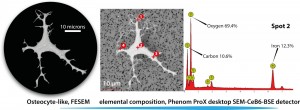
The Messel Pit is a worldwide famous fossil site recognized by UNESCO as a World Natural Heritage Site because of the exceptional preservation, as well as the diversity of its fossils from the early-middle Eocene (~48 Ma). The Messel Pit, located in an old Quarry in Germany near Frankfurt am Main , includes fossils from vertebrates (turtles, crocodiles, mammals, birds, lizards, among others), invertebrates (insects), and plants. The vertebrates are preserved in articulation, often with associated ‘‘soft ’’ tissues such as hair, scales or feathers, and even occasionally in situ stomach contents. Despite of the exceptional macroscopic (complete skeletons) preservation of Messel Pit vertebrates, the internal preservation of bones has been almost completely unexplored, leaving unresolved questions as for example if such exceptional preservation also occurs at microscopic and molecular level, allowing the recovery of bone proteins and even DNA.
A new research topic was started at the Senckenberg Museum in Frankfurt, focused on examining the preservation of blood vessels and bone cells-like (called osteocytes) from some of the Messel pit vertebrates. Osteocytes are remarkably important for understanding evolution since they are the most abundant cells forming bones in all vertebrates on Earth. After analysing very small pieces of fossil bones (less than 1 cm2), beautiful osteocytes-like and blood-vessels-like from two species of turtles, one mammal species, and one crocodile were discovered. It thus indicated that the exquisite preservation of Messel Pit vertebrates occurs at both macro (skeletons) and micro (cells-like) scales.

Step by step illustration of osteocytes-like cell analysis. Top-left (fragments less than 1 cm3 of bone from Messel pit vertebrates were taken for analysis). Middle-left (all the mineral phase of the bone are removed, leaving after only the osteocytes and blood vessels-like microstructures). Bottom-left (osteocytes and blood-vessels-like are observed and photographed using a light-transmitted microscope. Bottom-right (osteocytes are also observed under Field Emission Scanning Electron Microscope, to explore in detail their textures and physical properties) (Credit: Edwin Cadena, Senckenberg museum)
However, work on these bone osteocytes and blood vessels-like microstructures is not quite complete. It is also interesting to establish if there are any remains of their original molecular composition (proteins or even DNA) after 48 millions years of being trapped inside the rocks. Preliminary results show that osteocytes-like and blood vessels-like exhibit important amount of iron (Fe) in their composition, contrasting with bone remains and collagen fibrils-like that lack iron. Although no proteins or DNA remains have been found yet in the Messel Pit fossil vertebrates, the occurrence of iron is a good signal because iron has also been found in similar microstructures of dinosaurs bones from USA, in which proteins are truly preserved.

Analysis of the elemental composition of one of the osteocytes-like cells from a fossil turtle from Messel Pit, using a Phenom Pro X Scanning Electron Microscope. Red dots on the osteocytes indicate different spots that were analysed for compositional elements, as shown for example for spot 2, indicating a high content of iron (Fe), Carbon (C), and Oxygen (O2) (Credit: Edwin Cadena, Senckenberg museum).
At this point, it is clear that further research is needed for establishing the original biomolecular composition (amino acids and proteins) of fossil cells or soft tissue. If bone proteins – or even DNA- are preserved in Messel Pit fossils that could shed light on understanding evolutionary relationships, as well as the mode and rate of evolution at molecular levels, which is crucial for explaining different lineages of extant vertebrate animals, including us.
For further details, see Cadena (2016).
Reference:Cadena, E.A. 2016. Microscopical and elemental FESEM and Phenom ProX-SEM-EDS analysis of osteocyte- and blood vessel-like microstructures obtained from fossil vertebrates of the Eocene Messel Pit, Germany. PeerJ 4:e1618; DOI 10.7717/peerj.1618
————–
Dr. Edwin Cadena wrote this blogpost. He got a grant from the Alexander Von Humboldt foundation to perform his research on osteocytes from fossilized (in)vertebrates at the Messel Pit.
